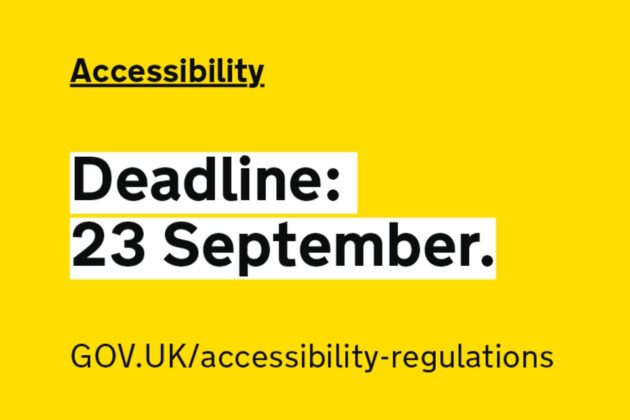Deadline for accessibility regulations – 6 weeks to go
It’s safe to assume that anyone working in a government communication role is motivated by the idea of doing a great job for the people we serve.
One of the ways we do that is through accessible services. That means making services that anyone can use. “What’s that got to do with me?” I hear you ask. “I don’t work in service design, I’m a communicator”. Actually, in many ways, you might be more involved in the world of services than you realise.
Take websites. Some of the most popular and widely used public services are offered through websites. Like applying for a passport or checking your council tax or finding a tasty local restaurant that’s registered for Eat Out To Help Out.
Websites should be created to ensure no one is excluded, whether they have a disability or not. Those that are built into GOV.UK, or use the GOV.UK Design System components, should have accessibility built-in from the get-go. But that’s not always been the case for all public sector websites.
In line with the vision to make services more accessible for all, by 23 September this year it will be a legal obligation for all public sector websites to meet certain requirements and publish accessibility statements. It is important that as a profession we take steps to ensure digital accessibility is in place ahead of the deadline, and to make sure there are no barriers that prevent people from using the key services that public sector websites provide.
Below we outline some of things you should be thinking about, and where to find more information about ensuring your website is compliant before 23 September 2020.

What public sector bodies need to do pre 23 September 2020: step by step
There is accessibility guidance for campaign site owners on the GCS website. Here we have created a step by step guide to help you towards meeting the 23 September deadline:
- Check your website for accessibility problems. To do this effectively you can use a sample to undertake a detailed audit yourself or contract a third party to do it for you. All methods involve checking your sample against the international WCAG 2.1 AA accessibility standard – depending on the resources that your organisation has.
- Create a roadmap to fix any accessibility problems. It is important to prioritise any tasks which could be more time consuming. This involves talking to people who know how long things will take to fix and how difficult each fix might be. Talk to:
- suppliers, about the technology behind your website
- developers who know about the code for your website
- content editors, publishers or people who edit the text and documents on your website.
- Decide whether or not potential issues need fixing under the regulations. A detailed list can be found on GOV.UK.
- Draft and publish an accessibility statement on your website. The Government Digital Service (GDS) has worked to ensure that accessibility statements have been published for GOV.UK as part of this ongoing work. However GOV.UK service owners are responsible for publishing specific information on the accessibility of their service individually.
This information should be published on an accessibility page which should be linked to from the service’s footer so users can easily find it. For more information you can read this blog post on accessibility statements.
Helpful Resources
GDS is adding more resources and practical guidance to the GCS website to empower your teams to create and publish accessible content to multiple channels, including social media.
For more information on making your website accessible please see the GCS page on government campaigns.
For more information and advice watch our Global Accessibility Awareness Day webinars to hear experts giving practical advice on improving digital accessibility across services and public sector websites.
Additionally, you can join the ‘Accessibility community’ on google groups for community support. You can also find information on the regulations at GOV.UK/accessibility-regulations and more guidance on writing accessible content on GOV.UK’s content design guidance pages.
Keep an eye out for more updates ahead of the deadline on the GCS website.
- Image credit:
- Government Digital Service (GDS) (1)
